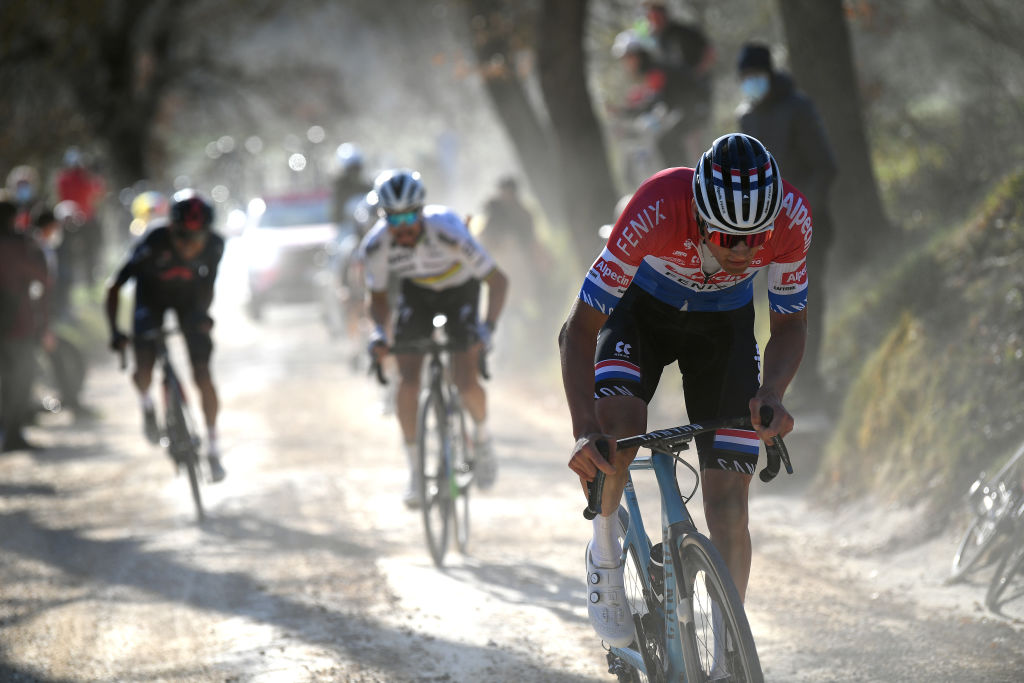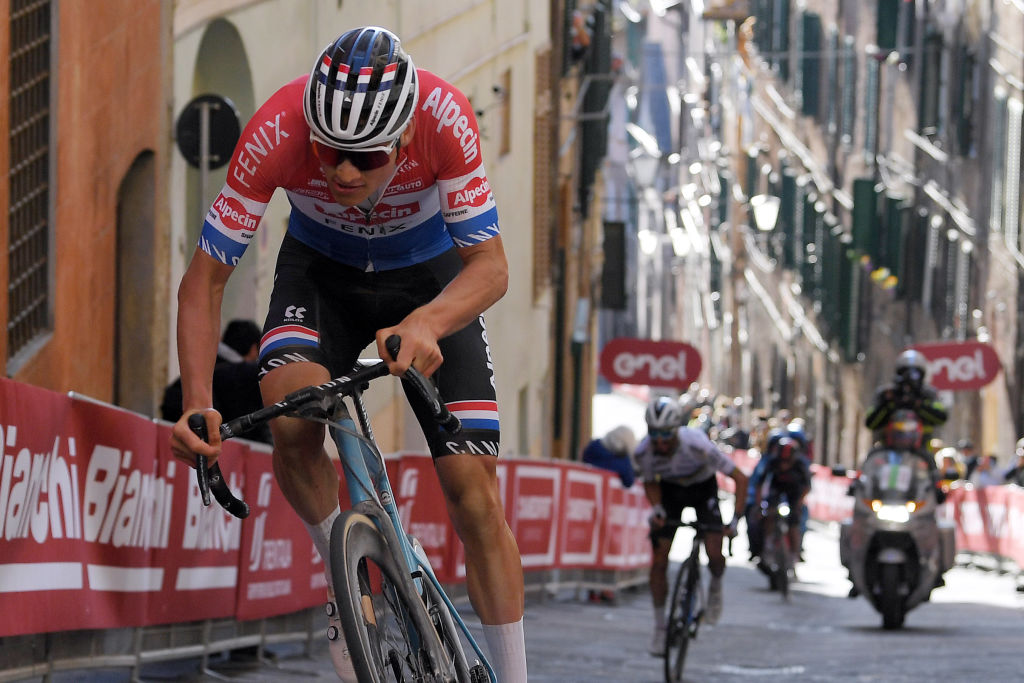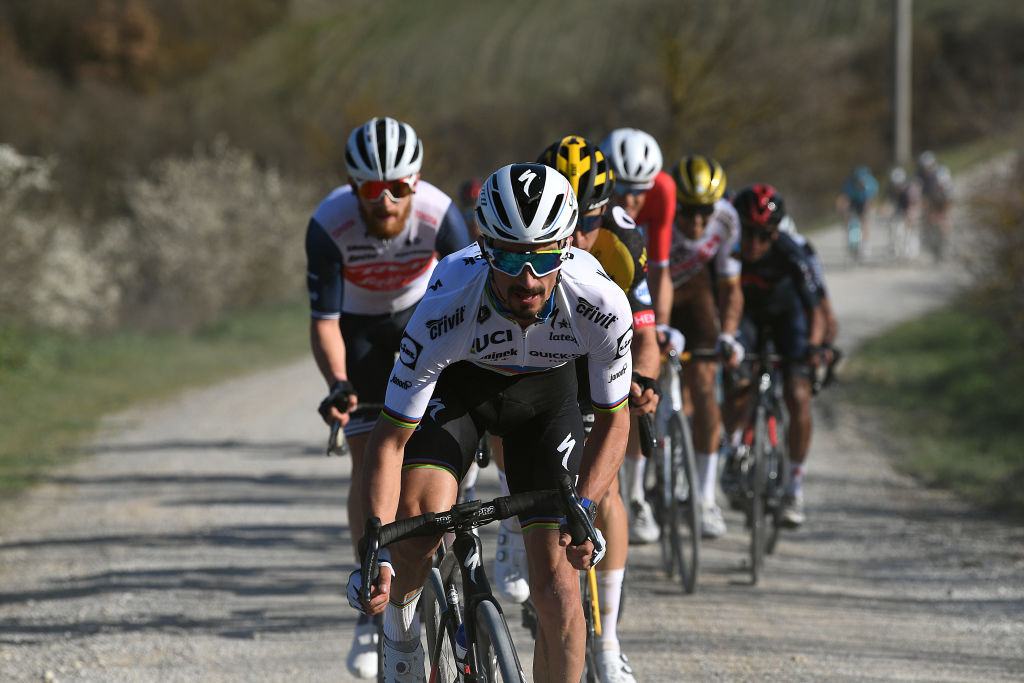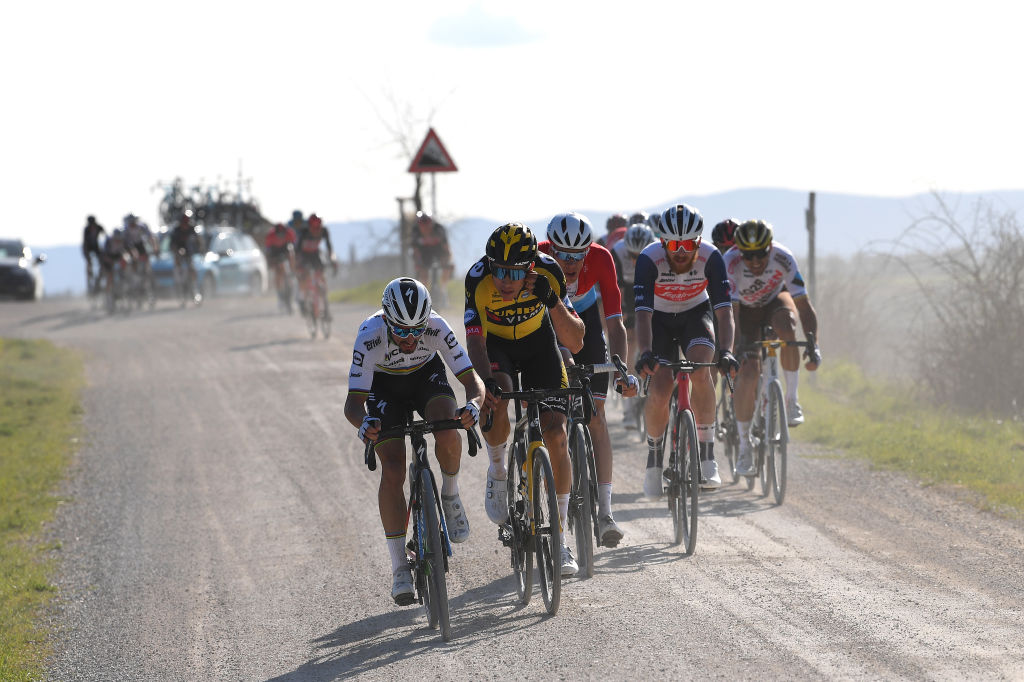5 conclusions from Strade Bianche 2021
Cyclo-cross is the new marginal gain, Bernal is back and why the monument ‘debate’ is moot

Since its inception in 2007, Strade Bianche has never failed to excite, and this year’s edition was no exception. A high-quality field produced a remarkable afternoon of racing, and the winning break proved a veritable who’s who of the best riders in contemporary cycling.
Strade Bianche also offered the latest instalment of the ongoing epic that is the Mathieu van der Poel-Wout van Aert rivalry, but it also saw fine displays from Egan Bernal and Tadej Pogacar, provided confirmation that Julian Alaphilippe will be a factor in every race this spring and highlighted the potential of Tom Pidcock.
We run the rule over these talking points, as well as the ongoing and perhaps futile ‘debate’ over Strade Bianche’s place in the firmament of Classics.
A Spring Classics campaign to savour
One great race doesn’t make a legendary spring Classics campaign but if what we saw at Strade Bianche is repeated for the next five weeks it should be a spring classics campaign to savour as Mathieu van der Poel, Wout Van Aert, Julian Alaphilippe and many others battle it out in some of the most spectacular one-day races of the season.
The Tuscany landscape and dirt roads make Strade Bianche a visually stunning race to watch but this year more than in recent years, it is the quality of the riders and their contrasting abilities and styles that should make for a great Classics season.
Mathieu van der Poel is already in superb form and has insisted he can hold the same level until Paris-Roubaix on April 11. Wout van Aert made his road racing debut after a three-week altitude camp and will surely improve in the weeks ahead. Julian Alaphilippe is also on an upwards trend, the rainbow jersey inspiring him to be more aggressive than usual.
Just the battles between those three should make for a rich ride towards Easter.
Get The Leadout Newsletter
The latest race content, interviews, features, reviews and expert buying guides, direct to your inbox!
There are also other riders who appear ready to bloom this spring: Tom Pidcock is only 21 and making an impressive debut at WorldTour level with Ineos Grenadiers. Just as in cyclo-cross, there is a real sense he has the ability to step-up and take on the big three in the weeks ahead.
It will be fascinating to see how Mads Pedersen and Jasper Stuyven combine for Trek-Segafredo, if Greg van Avermaet, Philippe Gilbert and Peter Sagan can still challenge the young generation pushing their way though, or if they will dethroned.
The story of the spring, of the big-name battles and rivalries will unfold week by week, race by race, from the warm spring sunshine of Milan-San Remo to the bergs and echelons of Flanders and then the punishing pavé of Paris-Roubaix.
It will be a spring to savour.

Cyclo-cross is the new marginal gain
A popular energy drink claims it gives you wings. However, cycling’s latest marginal gain does not appear to come from a can but from hard racing during the winter. Cyclo-cross is the new marginal gain.
The performances of Van der Poel, Van Aert and Pidcock in recent weeks appear to confirm that the intensity of cyclo-cross, huge natural talent and the related training techniques can go on to make the difference in subsequent spring road racing.
It seems that cyclo-cross can help sculpture peaks of form and top-end, anaerobic
efforts that traditional season preparation struggles to match. It should not be forgotten that Julian Alaphilippe’s career is rooted in the intensity that only cyclo-cross can provide.
Van der Poel is the arguably master of modern day racing and training, combining and carefully calibrating his training and racing across mountain biking, cyclo-cross and road racing.
He won his fourth cyclo-cross world title at the end of January and has since laid down a solid road racing endurance base, while somehow maintaining his high-end intensity. He powered away on the final dirt sector and then up the Via Santa Caterina at Strade Bianche just as he did on the bridge at the cyclo-cross World Championships in Ostende.
The ability to make that rocket man effort will surely be invaluable on the Poggio in two weeks’ time, on Oude Kwaremont and the Paterberg at the Tour of Flanders and then across the cobbles of Paris-Roubaix.

Alaphilippe ready to become third man in Van der Poel-Van Aert rivalry
Julian Alaphilippe could do little against Mathieu van der Poel when he surged away to victory at Strade Bianche but the Frenchman once again confirmed he is the third man in the Van der Poel-Van Aert rivalry.
Their rivalry goes back to when they were schoolboys in cyclo-cross, while Alaphilippe is a different kind of rider, with extra Grand Tour talents, but he has the same natural aggression and love of racing.
Strade Bianche was only the fifth time all three clashed in the same race at WorldTour level. Van der Poel now leads Van Aert 3-2, but Alaphilippe will surely chalk-up a win soon.
Deceuninck-QuickStep appear to be facing a generational change among their Classics leaders but Alaphilippe’ panache can easily help paper over any cracks in 2021. He is also inspired by racing in the rainbow jersey and is loving every minute of it. He was hurting after losing Strade Bianche but was quick to congratulate and praise Van der Poel.
“For me, the best way to honour this jersey is to stay true to what I've always been,” Alaphilippe said. “Stay true to my style of racing, to the way I got this jersey, which was by attacking and going on the offensive. I'm taking a lot of pleasure from racing at the moment."
So are we.

Bernal’s comeback continues apace
Egan Bernal’s mountain biking background, not to mention his solid track record in Italian one-day races, meant that his presence in the winning move on his Strade Bianche debut wasn’t altogether surprising, but it certainly augurs well both for his comeback from injury and his prospects when the Giro d’Italia visits the dirt roads of Tuscany on stage 11 to Montalcino in May.
Since the turn of the year, Bernal has repeatedly insisted that he will have to live with back pain for the foreseeable future, but in the opening weeks of the season, he hasn’t looked remotely impeded by the injury that ruined his Tour de France defence last September. He was on the attack at Étoile de Bessèges, he teed up Ivan Sosa on Mont Ventoux at the Tour de la Provence and he was the main aggressor at the Trofeo Laigueglia in midweek.
Then again, it’s easy to forget that Bernal’s form was just as encouraging in August of last year, when he dominated La Route d’Occitanie and then delivered a solid display when faced with Jumbo-Visma’s numerical superiority at the Tour de l’Ain. His season only took a sudden downturn with his abandon at the Dauphiné and he looked a different rider at the Tour.
For that very reason, Bernal won’t believe his back issues are over just yet. But it already seems clear that the Ineos man is riding with greater freedom – and perhaps a greater sense of enjoyment – than he was in 2020, when he carried the burden of being the defending Tour champion.
Reaching Siena ahead of his successor Tadej Pogacar – who was himself an impressive seventh – won’t have done his morale any harm either.
“I want to enjoy this podium place,” Bernal said, “and then look forward to my big, big goals.”

The monument ‘debate’ is moot
When then UCI president Hein Verbruggen was interviewed by Le Monde about the nascent World Cup in the spring of 1989, he pledged that the season-long series would safeguard cycling’s monuments, though he was notably hazy about the concept and, above all, about quite how many there were. He spoke of “providing a certain protection to the ‘monuments’ of cycling, to the five or six big races on the calendar, like Milan-San Remo, Paris-Roubaix or the Tour of Flanders.”
In the years since, the word has lost its quotation marks, and the concrete has seemingly hardened on the monument status of five races to the exclusion of all others. Nowadays, a newcomer would be forgiven for thinking that the five monuments had been set in stone as the most prestigious one-day races since cycling’s earliest days as an organised sport.
Far from it.
Classics have always risen and fallen in professional cycling – witness the cachet of events like the Grand Prix des Nations time trial, Paris-Brussels and Züri-Metzgete in the mid-20th century.
The terminology is nebulous. There was never any precise rule on the difference between a classic and a semi-classic, for instance, save the nagging feeling that a race with the word ‘classic’ in its title was probably protesting a bit too much.
In that light, the recent ‘debate’ about Strade Bianche’s monument status is moot.
Adding an extra 60km wouldn’t immediately make a monument out of Strade Bianche, but nor does it need to exist for a set number of years before being designated as such. Why? Because there are no defined parameters for what constitutes a monument and, besides, the title is essentially an honorific.
Rather than quibble pointlessly over its current place in the hierarchy of one-day races, then, one should simply enjoy Strade Bianche on its own merits and perhaps employ the preferred metric of one of Tuscany’s great cycling men.
Whenever the late Alfredo Martini was introduced to a promising young rider, he would gauge their talent not from the races they had won but by asking for the names of the riders they had beaten in order to win them.
The prestige of Strade Bianche is clear from the respect it is afforded by its participants. The winning break in the men's race included the world champion, the two best Classics riders of 2020 and the past two winners of the Tour de France. There is unlikely to be a higher-quality front group in a one-day race all year. The women's race was equally spectacular and highly fought with a superb show of strength by the SD Worx team.
Never mind the semantics. Bike races make their own importance.